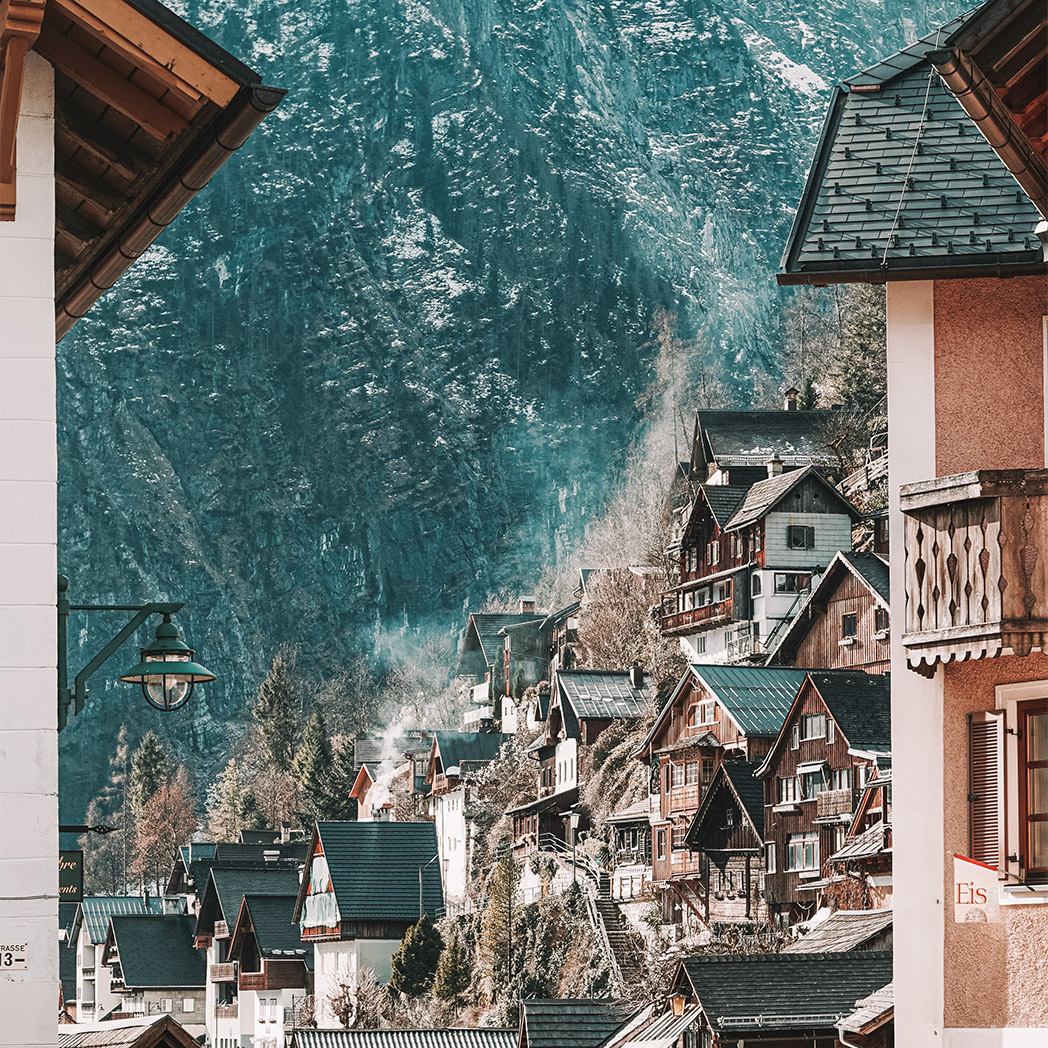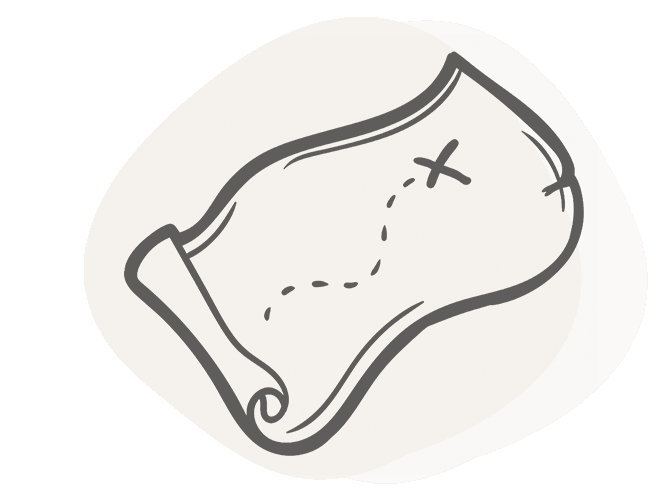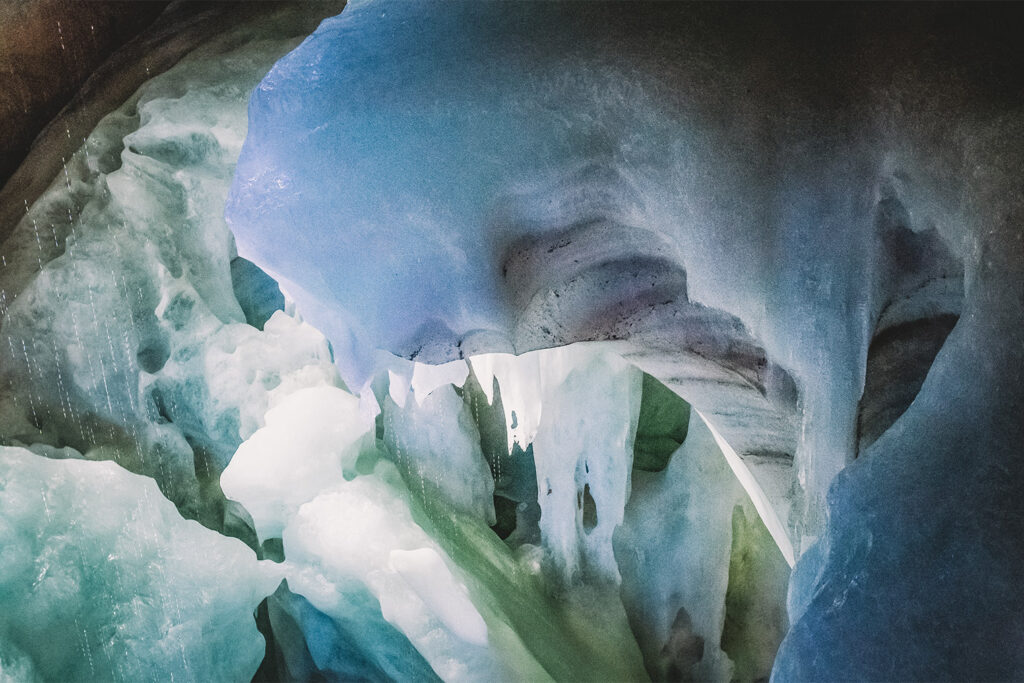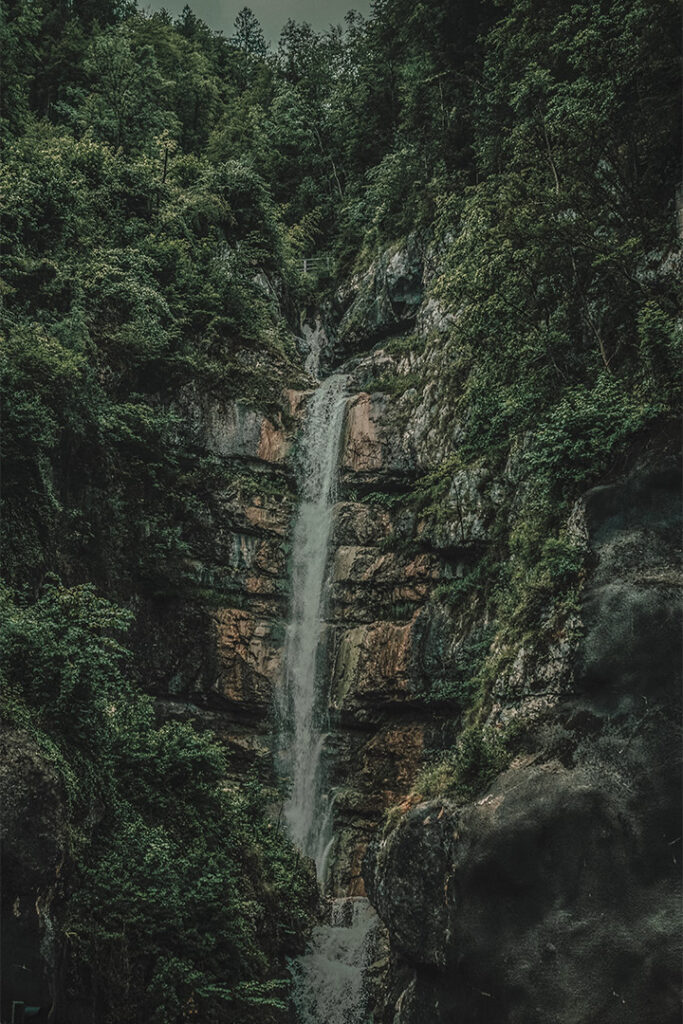
But Hallstatt is much more than just a pretty face. The area’s historical pedigree is superb, with salt being mined in the mountains above the lake since Neolithic times. Journey high above the village to Salzbergwerk, where a guided tour of the ancient salt mine will transport you back in time to witness the tools and techniques used for centuries.
From shimmering shoreline strolls to heart-stopping viewing platform vistas, and underground cave adventures to thrilling waterfall hikes, there’s something for every traveler. So set aside a full day and let our expert guide lead the way to the best things to do in Hallstatt!

Best Things to Do in Hallstatt
Hallstätter Lake Stroll
Take a leisurely walk along the waterfront as it’s the perfect starting point to explore the scenic village. You’ll be greeted with rustic gabled houses that cast shimmering reflections onto the glassy waters of the lake, graceful swans, and old wooden boats that add to the charming ambiance. It’s an experience that stands on its own!
The entire village can be easily explored within 20 minutes on foot, but don’t be surprised if you find yourself pausing every few steps to capture that perfect postcard-perfect shot. And just in case you can’t locate the renowned Hallstatt viewpoint, don’t worry; we’ve got you covered with its exact location included in our map below.

If you want to get out on the water, you can rent a boat or hop on a traditionally crafted wooden salt boat for a themed cruise.
Old Town & Market Square (Marktplatz)
The Market Square is the lively and bustling hub of the village, hosting open-air concerts and cultural events that bring the community together. Its centerpiece is the mighty Holy Trinity statue, towering over the square, while around it, you’ll discover charming cafés and the striking Gothic-style Lutheran Church.
As you explore the Market Square, you’ll notice a unique feature – colorful stone houses that stand out from the traditional timber buildings that Hallstatt is known for. They were built in the wake of a devastating fire that struck the village in 1750, reducing the majority of the square to ash and rubble and destroying 35 houses at the center.

Follow the labyrinthine alleys that wind upwards from the square, allowing yourself to lose track of direction as you explore the charming nooks and crannies of the village and soak up the breathtaking views below.
World Heritage Museum (Welterbemuseum)
The Welterbemuseum provides a wealth of information about the area’s rich cultural heritage, including its prehistoric past, the Celtic culture that once thrived here, and the salt mining industry that has been a vital part of the local economy for over 7,000 years ago. The museum’s exhibits feature artifacts such as tools, pottery, jewelry, and other items of cultural significance.
Directly opposite the museum, under the Janu Sports Shop, you can explore historical excavations that include building foundations, Habsburg residence outer walls, and salt mine forges with metal tools.
Catholic Parish Church (Pfarrkirche) & Ossuary (Beinhaus)
Perched on a terrace overlooking the village, stands the magnificent Pfarrkirche with its remarkable wooden bell tower that pierces the sky. This very church was the scene of a notorious art theft case in the 1980s, when a couple absconded with four priceless Gothic paintings from the small altar, leaving investigators scratching their heads for over three decades.
In the cemetery adjacent to the church, there is the Beinhaus, an ossuary housing around 1,200 human skulls. It was built to address the space constraints in the graveyard, which necessitated the removal and storage of the deceased’s bones. The skulls were painted with decorative designs, such as oak or ivy leaves for males and floral motifs for females, and sometimes included the deceased’s name, date of death, and cause of death.

Take in the breathtaking views of the village below, and if you’re up for a hike, follow the Hallstätter Höhenweg. Beginning at the back of the cemetery, the trail leads up to the stunning Marienruhe lookout point before winding its way to the Skywalk Platform.
Skywalk & Salt Mine
Experience the stunning Salzberg Valley, also known as the Hallstatt High Valley, located high above the village. Here you’ll discover the awe-inspiring Skywalk viewing platform and one of the world’s oldest-known Salt Mines.
At the entrance to the Salzberg area stands the medieval defense tower, Rudolfsturm, once the residence of the salt mine manager and now a restaurant. The Skywalk (Welterbeblick or World Heritage View), located just below, offers majestic views 360m above the rooftops of Hallstatt. Step onto the lookout platform and walk 12m out to its tapered point for an exhilarating experience.
Only ten minutes away, the Salt Mine (Salzwelten) can be explored on a 90-minute tour detailing its rich history. Journey down 60m miners’ slides, through mysterious tunnels, and to an underground salt lake for an unforgettable adventure.

To reach the top, you can either opt for the 5-minute funicular railway ride (Salzbergbahn) from the visitor center or take the trail behind the Beinhaus (moderate, 1h).

Admission to the Skywalk platform is free, while the Salt Mine charges €27 for entrance (APR-OCT 09.30-16.00, NOV-JAN 09.30-14.30). If you take the funicular up, expect to pay an extra €22 for a round trip or €12 for a single trip. For the best deal, go for the Combo Ticket., which costs €40 and covers the Salt Mine and the funicular round trip.


Attractions around Hallstatt
Dachstein Caves & 5 Fingers
For a perfect summer day trip, take the cable car from the nearby low-key village of Obertraun and explore the highlights of the Dachstein massif.
Getting off at its first station you can visit the captivating Dachstein Caves, where you will find yourself in a strange world of ice mountains, glaciers, and frozen waterfalls. The most interesting one is the Rieseneishöhle (Giant Ice Cave), with its formations being illuminated with colored light and taking eerie and surreal shapes. The Mammuthöhle (Mammoth Cave), so-called because of its size rather than after the prehistoric mammal, and the Koppenbrüllerhöhle are also worth visiting.
At the second station, discover three viewing platforms namely the Welterbespiral, the Weltnaturerbeblick, and the most spectacular of all, the 5Fingers. The latter juts out over a sheer cliff face with five uniquely shaped platforms, providing magnificent views. Test your vertigo with its glass floor allowing you to look straight down into the void.

From Hallstatt Lahn, take Postbus #543 and disembark at the Dachstein Cable Car Valley Station (Dachsteinseilbahn Talstation) after a 25-minute ride. Arriving by car, you can park free of charge at the Valley Station. From there, the cable car departs every 15 minutes and you can take it to the first station for the Dachstein Caves or the second station for the 5Fingers Viewing Platform.

Here are the operating hours and ticket prices for the cable cars and caves.
Gosauseen
The three small mountain lakes, known as Gosauseen, lie one after the other, surrounded by forest and limestone rocks. An undemanding walk around the biggest one, the Vorderer Gosausee, will reward you with superb views of the surrounding mountains. If you want to explore the rest, walk past the Gosaulacke (Lacke means puddle), and you will get to Hinterer Gosausee, a small green-blue lake enclosed within a host of stunning grey peaks.
And for an adrenaline-pumping experience with breathtaking views of the Gosausee, take on the Laserer Klettersteig (via Ferrata), but be prepared for a challenge.

From Hallstatt Lahn, first take Bus #543 to Gosaumühle (10min) and then change to Bus #542 to Hintertal b.Gosau Gosaukammbahn (24min). Alternatively, you can drive and park at the same location. The trailhead is easy to locate and follow.
Waldbachstrub Wasserfall
The imposing Waldbachstrub Waterfall in Echerntal Valley is Hallstatt’s hidden gem. You can easily get there from the center of the village, following the trail that starts from the P2 parking lot.
The hike takes about 1h 30min, while an extra 30min detour takes you to the marvelous Gletschergarten (Glacier Garden).

Himmelsleiter
The Himmelsleiter also referred to as Jacob’s Ladder, Ladder to Heaven, or Stairway to Heaven, is a popular destination for climbing enthusiasts. It is part of the Klettersteig Donnerkogel and is a Via Ferrata that spans a 40-meter gorge on the Donnerkogel, providing a thrilling experience for those who dare to cross it. Reservations can be made here.

From the Vorderer Gosausee, first, take the Gosaukammbahn cable car up into the Zwieselalm. Then take the path to the Gablonzer Hütte and finally follow the signs toward the official starting point of the Klettersteig Donnerkogel.

How to Get to Hallstatt
Although public transportation to Hallstatt may not be the most straightforward, it’s not overly challenging either. On the other hand, traveling by car to Hallstatt is effortless. The village is accessible from major cities in Austria, with Salzburg being the closest and most convenient one.
By Car
To reach Hallstatt, driving is the easiest and possibly cheapest option, especially if you’re not traveling alone. The village is located roughly 3.5 hours from Vienna, 2.5 hours from Graz, and 3 hours from Innsbruck, while Salzburg is only an hour’s drive away.

Parking: Hallstatt’s center is closed to cars during the daytime and the few existing parking spots are reserved for the inhabitants of the village. However, two main parking areas, P1 and P2, are available. P1 is closer to the village but fills up quickly, while P2 is a bit further away but still within walking distance. Both charge hourly and daily rates and shuttle buses run regularly between the parking areas and the village, making it easy to get around without a car.
By Train & Ferry
Traveling from Austria or Germany to Hallstatt by ÖBB train usually requires a transfer at Attnang-Puchheim. From this point on, only (slightly) slower regional trains run to Hallstatt, calling at the Hallstatt Bahnhof, on the east bank of the Hallstätter See.
As the village lies on the west bank, you will have the unique experience of approaching Hallstatt across the water. A ferry service meets each arriving train and takes you to the Schiffstation, just north of the Marktplatz (€3, buy on the spot).

Book your train tickets well in advance, as prices tend to increase closer to the travel date. Also, check out the Einfach-Raus-Ticket which allows up to five people to travel together throughout Austria on regional trains and some buses for a fixed price. The ticket is valid for one day of travel and its price depends on the number of people traveling, starting at €36 for a single person and increasing by €4 for each additional one.
By Bus (from Salzburg)
From Salzburg, you can reach Hallstatt by taking the bus route as well, but it involves changing buses twice. First, board bus #150 to Bad Ischl (1h 25m, every 30min), then transfer to #542 heading to Hallstatt Gosaumühle (30min, every 20min), and finally, take bus #543 to Hallstatt Lahn (10min, hourly). Once you reach Hallstatt Lahn, it’s only a brief walk to the village.

Price: Tickets cost around 15€ each way and can be purchased from the first bus driver. Just inform them that you’re heading to Hallstatt Lahn to avoid buying separate tickets.
— BY ORGANIZED TOUR —
Getting around Hallstatt
With no cars allowed in the village during the day, it is effortless to explore Hallstatt on foot. In addition, it is so compact that you can stroll from one end to the other in less than 30 minutes. And if you’re feeling more adventurous and want to explore beyond the village, you can take the funicular up to the Salt Mines or catch the local bus to the Ice Caves.

Where to Eat in Hallstatt
Most eateries in Hallstatt tend to close when the tourist buses stop arriving, so if you plan on dining later in the evening, you may need to reconsider. While there are a few restaurants, they tend to be quite touristy and lack variety in their offerings. However, if you’re looking for a quick and casual bite, there are some cafes and casual spots that may be more up your alley.
• Muk´s Schmankerl: This casual spot offers coffee to go and a tasty selection of wood-fired pizzas and light snacks.
• Seecafé Hallstatt: Seecafé guarantees breathtaking views of Lake Hallstatt, whether you choose to sit on the outdoor terrace in summer or enjoy the view from the large windows during winter. Don’t miss their delicious avocado toast with eggs!
• Burgerman The Station: If you’re in the mood for a juicy burger and crispy fries, this is the place to head to. Vegetarian and vegan options are available as well.
• I da Mitt: At this laid-back eatery, you can indulge in delicious Flammeküche while sipping on a glass of wine or beer. In fact, it was the only place open on a Saturday night to grab a drink.

Where to Stay in Hallstatt
By staying overnight in Hallstatt you will make the most of your visit and explore the village at your leisure without the crowds. However, if the limited availability of affordable rooms is an issue, consider nearby villages as an alternative.
Obertraun, for instance, is just a short bus ride away and provides an excellent base for exploring the stunning caves and 5-Fingers nearby. Hop on Bus #543 from Hallstatt Lahn and you’ll be there in just 7 minutes for a fare of €2.30.
If you prefer hiking, Bad Goisern offers some picturesque walking paths, while the village of Gosau provides access to the stunning Gosauseen. To reach these villages, take Bus #543 from Hallstatt Lahn to Gosaumühle (10 minutes), then switch to Bus #542 to Bad Goisern (11 minutes) or Gosau (17 minutes)
— Accommodation in Hallstatt —
Haus Franziska (budget): Haus Franziska is a charming bed and breakfast located just a few steps away from the spot where the iconic Hallstatt photo is taken. Guests are required to stay for a minimum of three nights and can look forward to waking up to freshly baked goods delivered straight to their door.
I da Mitt (mid-range): Conveniently located in the central square, I da Mitt offers both dining options and comfortable accommodation with a complimentary daily breakfast buffet. The hotel’s rooms and suites are elegantly decorated in a traditional Austrian style, featuring wooden furnishings and floors, and some even have exposed wooden beams, enhancing its rustic charm.
Polreich: Experience a waterfront oasis where you’ll feel as though you’re floating on the lake, surrounded by magnificent mountains. Wake up each day to a mouthwatering breakfast and stunning views right outside your window.

When to Visit Hallstatt
No matter what time of year you choose to visit, Hallstatt’s enchanting allure remains ever-present, whether it’s blanketed in snow, adorned with the vibrant colors of autumn, or bursting with verdant greenery. Therefore, determining the best time to visit Hallstatt depends on your preferences and what you want to experience during your trip.
If your goal is to steer clear of crowds, keep in mind that summer is the busiest season, but winter can also be bustling, particularly during the Christmas period. However, if you plan on exploring other destinations such as the Salt Mine or the Dachstein Caves, the best time to visit is from late spring to early autumn.
And if you’re hoping to visit this lovely village for a special event, we’ve got you covered.
— special events in hallstatt —
| June (Thursday after Trinity Sunday) – Corpus Christi Procession: This is a centuries-old tradition that originated in the old salt-mining village when the Jesuits held colorful processions. Due to limited space, the procession moved to the Hallstätter See on salt-carrying ships and traditional boats decorated with flowers and garlands, providing locals with a beautiful view of the “Salt Mountain,” which had been their source of income for thousands of years.
| 29th of November – St Nicholas crosses the lake: Every year, the charming shores of Lake Hallstatt are illuminated by the twinkling torches of Obertraun’s children, as they eagerly await the arrival of the legendary St. Nicholas. He crosses the lake in a traditional wooden boat, carrying a generous sack filled to the brim with mouth-watering apples, nuts, and chocolate.
| 5th of December – Krampus Procession: On the Eve of St. Nicholas, the Krampus tradition comes to life as locals dressed in spine-chilling, hand-crafted masks descend from the Hirlatz Cave, perched high above Hallstatt. While St. Nicholas rewards good behavior, the Krampus take it upon themselves to punish the naughty children.
| 8th of December – Hallstatt Christmas Market: The Hallstatt Christmas Market is open for only one day each year. Marvel at the intricate three-dimensional crib scene and tantalize your taste buds with the famous Christmas cookies and spicy smoked fish, freshly caught from the nearby Lake Hallstatt.

Hallstatt Map
From its idyllic location nestled between mountains and the serene lake to its rich cultural heritage and fascinating history, there is no shortage of reasons why Hallstatt is worth a visit. So if you’re planning a trip to Austria, be sure to include a stop in this enchanting village and discover for yourself what makes Hallstatt the jewel of the Salzkammergut.